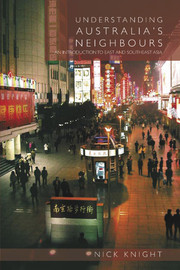Book contents
- Frontmatter
- Contents
- List of illustrations
- Acknowledgments
- Maps
- Introduction: Thinking about Asia, thinking about Australia
- 1 The Idea of ‘Asia’: Australia's ‘Near North’ – East and Southeast Asia
- 2 Tradition and Modernity in East and Southeast Asia: The family
- 3 Tradition and Modernity in East and Southeast Asia: Religion
- 4 Colonialism in East and Southeast Asia: How important was the impact of the West?
- 5 Nationalism and Revolution in East and Southeast Asia
- 6 Nations and Nation-Building in East and Southeast Asia
- 7 International Politics and East and Southeast Asia: The Cold War and the Sino-Soviet Split
- 8 The Rise and Decline of the Japanese Economic ‘Miracle’
- 9 The Newly Industrialising Economies of East and Southeast Asia: Economic growth and economic challenge
- 10 Democracy and Human Rights
- 11 Globalisation and East and Southeast Asia
- 12 Australia and Asia, ‘Asia’ in Australia
- Bibliography
- Index
- Plate section
Introduction: Thinking about Asia, thinking about Australia
Published online by Cambridge University Press: 05 June 2012
- Frontmatter
- Contents
- List of illustrations
- Acknowledgments
- Maps
- Introduction: Thinking about Asia, thinking about Australia
- 1 The Idea of ‘Asia’: Australia's ‘Near North’ – East and Southeast Asia
- 2 Tradition and Modernity in East and Southeast Asia: The family
- 3 Tradition and Modernity in East and Southeast Asia: Religion
- 4 Colonialism in East and Southeast Asia: How important was the impact of the West?
- 5 Nationalism and Revolution in East and Southeast Asia
- 6 Nations and Nation-Building in East and Southeast Asia
- 7 International Politics and East and Southeast Asia: The Cold War and the Sino-Soviet Split
- 8 The Rise and Decline of the Japanese Economic ‘Miracle’
- 9 The Newly Industrialising Economies of East and Southeast Asia: Economic growth and economic challenge
- 10 Democracy and Human Rights
- 11 Globalisation and East and Southeast Asia
- 12 Australia and Asia, ‘Asia’ in Australia
- Bibliography
- Index
- Plate section
Summary
many of the readers of this book will have travelled or lived in East and Southeast Asia, perhaps as backpackers, students studying a foreign language or tourists enjoying a few weeks in an exotic location. Their initial feeling, like my own when arriving in an Asian destination, is probably one of being overwhelmed by unfamiliar sensations and impressions. The familiar gives way to the unfamiliar. Sights, sounds, smells, and tastes are usually different, and often very different, from those with which we are familiar. Things are organised in different and sometimes seemingly bizarre ways. Our expectations of how things should be are frequently proved faulty, and this can be a disorienting experience. For some, one brush with the unfamiliar will be sufficient. Others, and I number the readers of this book among them, will find the initial confusing contact with Asia a challenge. They will want to move beyond first impressions to discover what lies beneath the surface. The tourist's passing interest in the quaint and exotic gives way to a desire to understand how peoples from other cultures live and think, to discover the ways in which their societies are different from and the same as our own.
This is a commendable goal, particularly so for Australians. But how does one achieve it? The answer I give, and which is the central theme of this book, is to think about Asia.
- Type
- Chapter
- Information
- Understanding Australia's NeighboursAn Introduction to East and Southeast Asia, pp. 1 - 4Publisher: Cambridge University PressPrint publication year: 2004



